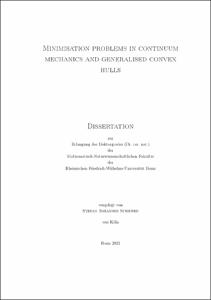Schiffer, Stefan Johannes: Minimisation problems in continuum mechanics and generalised convex hulls. - Bonn, 2022. - Dissertation, Rheinische Friedrich-Wilhelms-Universität Bonn.
Online-Ausgabe in bonndoc: https://nbn-resolving.org/urn:nbn:de:hbz:5-68730
Online-Ausgabe in bonndoc: https://nbn-resolving.org/urn:nbn:de:hbz:5-68730
@phdthesis{handle:20.500.11811/10460,
urn: https://nbn-resolving.org/urn:nbn:de:hbz:5-68730,
author = {{Stefan Johannes Schiffer}},
title = {Minimisation problems in continuum mechanics and generalised convex hulls},
school = {Rheinische Friedrich-Wilhelms-Universität Bonn},
year = 2022,
month = nov,
note = {The goal of this thesis is the analysis of functionals subject to a differential constraint. These functionals appear in minimisation problems which are connected to problems coming from continuum mechanics. In the introductory chapter of this thesis we further explain the connection between the physical problems and their mathematical formulation. Chapter 2 is concerned with the study of the differential constraint. It mostly features auxiliary results that are needed in later sections. Moreover, we compare two concepts of the constant rank property with respect to two different base fields, R and C.
The aim of Chapters 3 and 4 is to derive an abstract theory regarding weak continuity and weak lower-semicontinuity of functionals. This is connected to a generalised notion of convexity for functions, so called A-quasiconvexity. Employing the direct method of the calculus of variations, these results can directly be applied in the analysis of minimisers for the aforementioned functionals. Chapter 3 studies the significantly stronger notion of A-quasiaffinity and gives and extended version of previously known characterisations of A-quasiaffine function. In contrast, Chapter 4 examines the equivalence between A-quasiconvexity and lower-semicontinuity, with a focus on a weak growth assumption. The knowledge acquired in Chapters 3 and 4 is applied in Chapter 5. In that chapter, we examine a data-driven approach to fluid mechanics in a stationary setting that has previously been employed in the study of solid mechanics. In particular, we show a result that connects convergence of data sets to convergence of corresponding functionals and minimisation problems.
In the second part of this thesis, Chapters 6-8, we consider a notion of convexity for sets that is directly connected to the previously mentioned notion of convexity for functions. This notion of convexity has been analysed subject to the specific constraint of being a gradient, so called quasiconvexity. The aim of the second part is to show the validity of some statements that are known for the setting of quasiconvexity to general differential operators. Chapters 7 and 8 are summaries of their respective counterparts, Chapters A and B, which rely on the publications [134] and [20], respectively, and are therefore presented in the appendix.
One of the main statements is that a suitable convex hull of a set does not depend on an exponent whenever the set itself is compact. This result relies on a truncation technique that constructs a cut-off version of a function that still satisfies the differential constraint. The consequences of this truncation theorems in the framework of convex sets is discussed in Chapter 6. The truncation statement itself is shown in two physically relevant settings: in Chapter A for closed differential forms and in Chapter B for the divergence of symmetric 3 × 3 matrices.},
url = {https://hdl.handle.net/20.500.11811/10460}
}
urn: https://nbn-resolving.org/urn:nbn:de:hbz:5-68730,
author = {{Stefan Johannes Schiffer}},
title = {Minimisation problems in continuum mechanics and generalised convex hulls},
school = {Rheinische Friedrich-Wilhelms-Universität Bonn},
year = 2022,
month = nov,
note = {The goal of this thesis is the analysis of functionals subject to a differential constraint. These functionals appear in minimisation problems which are connected to problems coming from continuum mechanics. In the introductory chapter of this thesis we further explain the connection between the physical problems and their mathematical formulation. Chapter 2 is concerned with the study of the differential constraint. It mostly features auxiliary results that are needed in later sections. Moreover, we compare two concepts of the constant rank property with respect to two different base fields, R and C.
The aim of Chapters 3 and 4 is to derive an abstract theory regarding weak continuity and weak lower-semicontinuity of functionals. This is connected to a generalised notion of convexity for functions, so called A-quasiconvexity. Employing the direct method of the calculus of variations, these results can directly be applied in the analysis of minimisers for the aforementioned functionals. Chapter 3 studies the significantly stronger notion of A-quasiaffinity and gives and extended version of previously known characterisations of A-quasiaffine function. In contrast, Chapter 4 examines the equivalence between A-quasiconvexity and lower-semicontinuity, with a focus on a weak growth assumption. The knowledge acquired in Chapters 3 and 4 is applied in Chapter 5. In that chapter, we examine a data-driven approach to fluid mechanics in a stationary setting that has previously been employed in the study of solid mechanics. In particular, we show a result that connects convergence of data sets to convergence of corresponding functionals and minimisation problems.
In the second part of this thesis, Chapters 6-8, we consider a notion of convexity for sets that is directly connected to the previously mentioned notion of convexity for functions. This notion of convexity has been analysed subject to the specific constraint of being a gradient, so called quasiconvexity. The aim of the second part is to show the validity of some statements that are known for the setting of quasiconvexity to general differential operators. Chapters 7 and 8 are summaries of their respective counterparts, Chapters A and B, which rely on the publications [134] and [20], respectively, and are therefore presented in the appendix.
One of the main statements is that a suitable convex hull of a set does not depend on an exponent whenever the set itself is compact. This result relies on a truncation technique that constructs a cut-off version of a function that still satisfies the differential constraint. The consequences of this truncation theorems in the framework of convex sets is discussed in Chapter 6. The truncation statement itself is shown in two physically relevant settings: in Chapter A for closed differential forms and in Chapter B for the divergence of symmetric 3 × 3 matrices.},
url = {https://hdl.handle.net/20.500.11811/10460}
}






